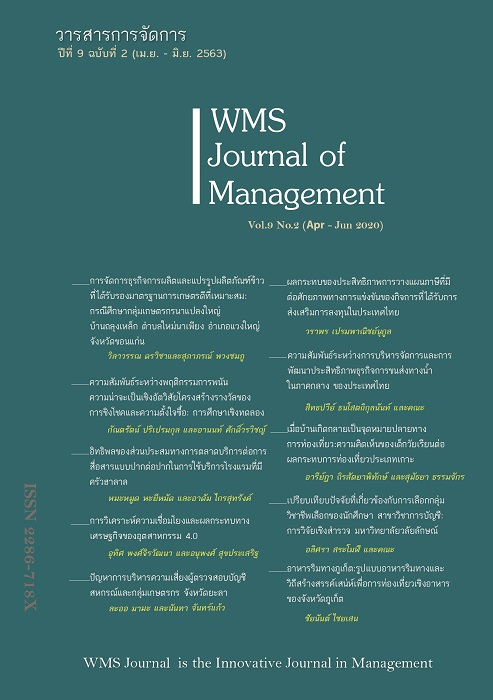Phuket Street Food: STREET FOODS Model Providing a Creative Charm for Phuket’s Gastronomy Tourism
Main Article Content
Abstract
Street food business is considered to be a major part of the local economy. This important mechanism for expanding microeconomic stability can help to create an economic value to extend from the region to the country. In 2017, the street food market was worth 276,000 million baht and is expected to increase to 340,000 million baht in 2021. This provides for and increased growth average rate of 5.3 percent per year. There are approximately 103,000 street food restaurant operators or 69% of the restaurant service business in the region. Therefore, Phuket should develop and organize a street food business plan identifying its unique attraction for tourists. The street food business operators should comprehend and implement this model for the operation and management plan outlined in the “STREET FOODS Model” consisting of Sanitation and Safety, Taste, Research and Innovation, Exceed Service, Environmentally Friendly, Thai-ness, Food Identity, Online Marketing, Organize, Do it, and Supporting. Additionally, various government departments should provide a systematic support system accompanied by supervision in order to apply street food standards. Providing more attraction for tourist by upgrading the standard of service and creating a unique charm, for the street food businesses of Phuket while developing a city of gastronomy thus attracting world class tourists.
Article Details
References
Best Living Taste Bangkok (BLT). (2017). When Street Food Needs to Go Online. Retrieved from http://www. bltbangkok.com/ CoverStory/When Street Food Needs to Go Online
Boonpienpon, N. (2017). Street Food: Thailand’s Charm for a New Tourism Experience in Asia. Veridian E-Journal,Silpakorn University Humanities, Social Sciences, and Arts, 10 (1), 47-60.
Boonsrirat, W. (2018). Food Development Guidelines for Tourism in Phuket. Retrieved from http://tour. nida.ac.th /wp-content/ uploads/2017 /05/phuket-gastronomy.pdf
Chamroennusit, W. (2018). Thai Food Street will Step into the World Food power. Retrieved from http://www. aseanthai.net/ewt_news.php?nid=8213&file name=index
Chantawibul, A. (2017). The Charming Andaman. Retrieved from http://advisor.anamai.moph .go.th/download/Journal _health/ 2560/ HEALTH40_4/HEALTH_Vol40No4_02.pdf
Chavarria, C. T. L. C. & Phakdee-Auksorn, P. (2017). Understanding international tourists' attitudes towards street food in Phuket, Thailand Tourism Management Perspectives, 21, 66-73.
Delisle, H. (1990). Patterns of Urban Food Consumption in Developing Countries: Perspective from the 1980’s. Department de Nutrition, Universite de Montreal. (FAO, Rome, Italy).
Department of Tourism. (2018). Street Food Standards of Thailand 2018 for Tourism. Bangkok, Thailand.
Devlieghere, F. (2016). Food safety knowledge, attitudes and practices of street food vendors and consumers in Ho Chi Minh city, Vietnam. Food Control, 70, 79-89.
Food Institute. (2017). Street Food at Thailand.Retrieved from http://fic.nfi.or.th/MarketOverview DomesticDetail.php?id=145
Jianwarophat, U. (2013). Behavior of foreign tourists towards consuming street food in Mueang Chiang Mai District. Independent study, Master of Business Administration. Chiang Mai: Chiang Mai University.
Khongharn, R. & Seangon, A. (2018). Marketing Strategy to Creating Modern Street Food in Bangkok. Panyapiwat Journal, 10 (1), 91-103.
Kritsanaprakornkit, W. (2017). Foodie Experience Food will keep us alive “Food Tourism Trend 2017”. Retrieved from https://etatjournal.files.wordpress .com/2017/01/tat12017-rev2.pdf. Vol. 3 No. 1 Jan-Mar 2017.
Liu, Z., Zhang, G., & Zhang, X. (2014). Urban street foods in Shijiazhuang city, China: Current status, safety practices and risk mitigating strategies. Food Control, 41, 212-218.
Mongkonkeeree, N., and Agmapisarn, C. (2018). A Case Study of Push and Pull Factors Influencing Thai Tourists’ Purchase Behavior of Street Food: Case Study of Hua Hin Night Market, Prachuap Khiri Khan Province. BU Academic Review, 17 (1), 18-32.
Payuhanaveechai, C. (2019). “GSB "reveals 4D formula to overhaul" Street Food "with a reality show. Retrieved from https://marketeeronline.co/archives/98202
Ratnitipong, T. (2011). Factor Affecting Street-Food Consumption Behavior of Working-Age Consumers on Silom Road. Master’s Project, Master of Business Administration (Marketing). Graduate School, Bangkok: Srinakharinwirot University.
Sangtoop, P., & Agmapisarn, C. (2018). A Study of Push and Pull Factors Infl uencing Thai Consumers’ Purchase Behavior of Street Food: Case Study of Yaowarat (Chinatown), Bangkok. Chulalongkorn Business Review, 40 (156), April-June 2018, 103-145.
Saovapruk, Y. (2018). Good Opportunity for Street Food Restaurant. Retrieved, from https://www.prachachat.net/economy/ news-153570
Sukkong, P. (2017). Why UNESCO Chose Phuket Is a Creative City in Food Science, with 7 Coordinates of Delicious Hokkien Chinese Style Dishes? Retrieved from https://thestandard.co/lifestyle-travel-unesco-good-food-in-phuket/
Samapundo, S., Thanh, T. C., Xhaferi, R., and Shea, G. (2017). World’s 23 best cities for street food. Retrieved from http://edition.cnn.com/2016/08/08/foodanddrink/best-cities-street-food/
Tang-utai, K. (2017). Creative City of Gastronomy by Unesco. Retrieved 25 March 2019, from https://www.phuketemagazine.com/ Creative City of Gastronomy
Trafialek, J., Drosinos, E. H., Laskowski, W., Jakubowska-Gawlik, K., Tzamalis, P., Leksawasdi, N., ... and Kolanowski, W. (2018). Street food vendors’ hygienic practices in some Asian and EU countries–A survey. Food control, 85, 212-222.


